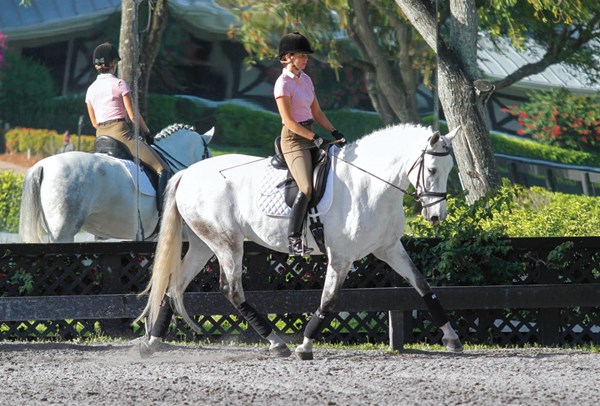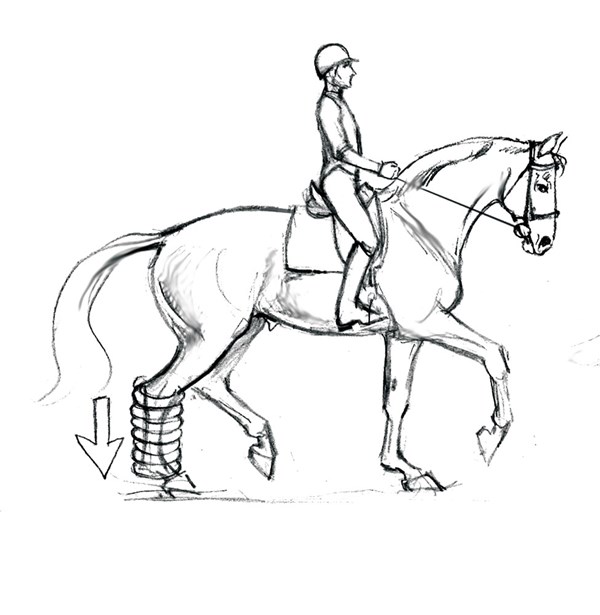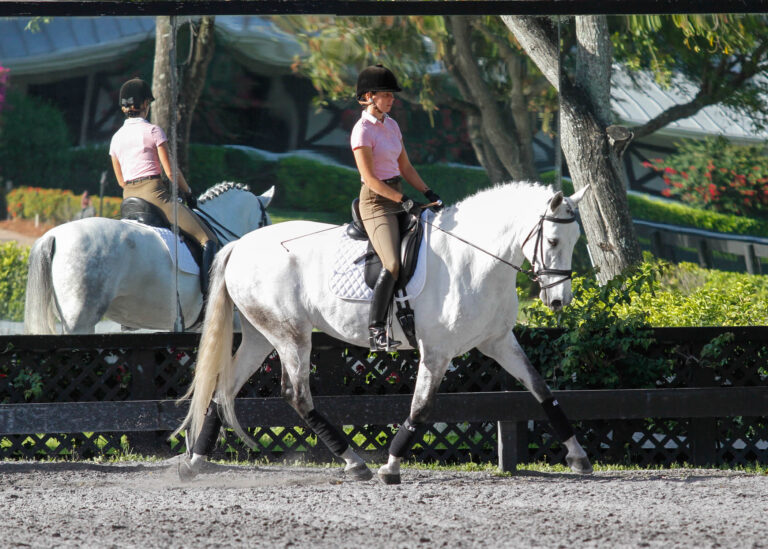Dressage horses often live long, healthy lives—especially when ridden by riders who have a feel for balance. In fact, the best thing you can do for your horse’s health and longevity is to ride him in a way that’s friendly to his body—in a way that makes him stronger instead of stressing him out. That means riding him in balance because tension and stress are inevitable when your horse is out of balance. When in balance, your horse is free to move forward in rhythm, with suppleness, reaching for the bit—all without tension.
Horses have a few innate balance issues even without the weight of a rider, and the successful rider is always managing those issues. Two of the balance issues are longitudinal, or back to front.

Back-to-Front Balance Issues
First, the horse by nature is inclined to be more eager with the forehand than the hindquarters. As a result, the forehand and the hindquarters aren’t always coordinated with one another. When you ask your horse to do an upward transition from halt to walk, walk to trot or trot to canter, what happens? Does your horse give you a whole-bodied response in the upward transition or is he inclined to initiate movement with just his front end? If you’re like most, your horse moves off with the front end and he is fairly unconscious about his hind end so it drags behind him as if it were a trailer behind the pulling front end. In fact, we can think of the front end as the “pulling engine” and the hind end as the “pushing engine.”

When the pulling engine is dominant in the moment of any upward transition, the horse covers a little more ground with the front end than with the hind end. As a direct result, the horse gets a bit long in the frame, hollow in the back (with the shoulders down) and sometimes unpleasant in the hand. When the hindquarters are the driving force, causing the horse to cover ground, it has the effect of lifting the forehand.
Likewise, check out your horse’s downward transitions. When going from canter to trot, trot to walk or walk to halt, what stops first? Often it is the hind end that quits as the front end keeps going. The result is the same sprawled horse that is hollow and tense in the back, on the forehand and unpleasant in the hand.
Of course, the horse has an even more basic balance issue: He is innately built on the forehand because his relatively large head and neck protrude off an otherwise table-like structure.
All horses have these problems, so the question is: When your horse looks like some variation of the horse on the left in the above drawing, what can you do to make him look like the horse on the right?
The Solution
Half halts and transitions are the rider’s primary tools to improve the balance of the horse. With these tools, you will gently and persistently teach your horse to respond with his back and hindquarters to your seat and leg aids. He shouldn’t respond with his front end first. You want his forehand to relax and wait a second so your horse doesn’t sprawl onto the forehand and you want your horse’s hind legs to work more eagerly with you.
But how do you want your horse’s hindquarters to work with you? It helps to be specific about what you want. Let’s look at the three things your horse’s hind leg does (see drawings below):
1. It thrusts (off the ground),
2. then it reaches (ideally under your center of gravity),
3. and finally it engages or carries weight appropriately for his training and strength.
Decide what you want from your horse’s hindquarters. If you need more power, then you need more thrust. If the power is making your horse stiff, you need less thrust. If he pops his hindquarters off the ground or becomes crooked behind the saddle, he is avoiding engagement. If he is crooked, you also need to refine the reach. Maybe you don’t necessarily want more reach, but you want him to reach to a specific place—under your center of gravity, instead of to the side. We’ll talk more about reach in the section “Lateral Issues” on page 41.
As I said, transitions and half halts help your horse’s coordination and balance. Let’s look at how each works.



Half Halts
Half halts balance your horse by helping him wait with his forehand and work more specifically with the hindquarters. The half halt is sometimes not understood clearly because it can mean so many different things. For example, it can mean:
• Balance under me in shoulder-fore right.
• Balance under me in preparation for an extension.
• Balance under me in the shape of a 10-meter bend left.
• Balance under me before this change of direction.
• Balance under me in preparation to jump this fence.
And we could go on and on. A half halt means countless things, but it always means “balance under me” by waiting with the forehand and getting the hindquarters in a position to carry. The balance is best when the center of gravity of the rider is directly over the center of gravity of the horse and the horse steps with his inside hind foot directly under that point.
Contrary to the mystifying reputation of half halts, anyone can do them. It’s true that the more experience you have, the more successful they will be, but the sooner you start, the better. See “How to do a Half Halt” below. Then try Exercise 2 below to improve your half halts.
Transitions
Transitions, like half halts, also ask your horse to “balance under me.” But, doing transitions with your horse might not help him much unless you understand why you are doing them and you are looking for the desired result. Here’s what you want to happen:
• When downward transitions are successful, they give you the same result as the “whoa” portion of the half halt: They close the horse’s frame from behind and connect the rein aid to the hindquarters. Sometimes they also transfer weight from the front to the back. Downward transitions teach your horse to wait with the forehand and engage (by carrying weight appropriate to his level of strength and training) the hindquarters.
• Upward transitions teach your horse to thrust and reach with the inside hind leg under your center of gravity. Exercise 2 will improve the effectiveness of your transitions.
Lateral Balance
The balance of horses are also laterally challenged not only because they are inclined to be either left- or right-sided in the same way that people are either right- or left-handed. Also, horses are anatomically wider in the hindquarters than they are in the forehand (see photo at right). The horse’s wide hindquarters thrust his weight onto the forehand. Those wide hindquarters also mean he can’t track straight. As the horse moves on a straight line down the track, the inside hind leg is, without the help of an educated rider, traveling on a track of its own, closer to the inside of the arena than it should be. Because of the horse’s natural left- or right-handed (hoofed) situation, this is even more often the case when the horse is tracking right. Not only is the right hind leg not carrying its share of weight, the thrust of the right hind leg sends the horse’s shoulders off to the left, making the horse heavy in the left rein.

Horses are completely unable to fix this situation on their own. When they are well-educated, they can easily be straightened by an educated rider because they understand, but the horse will never volunteer to be straight. He needs the rider’s help.
The Solution: It’s the rider’s first job to narrow the track of the inside hind so that it tracks behind the inside fore and then to further narrow it (to the left in this case in which the horse is tracking right) until it steps in the space between the horse’s front feet, which is ideally underneath the rider’s and the horse’s aligned center of gravity. As the horse narrows the inside hind leg to the left, it will, of course, be his inclination to accommodate with the outside hind by moving it to the left also, but you want that hind leg to continue tracking behind the outside hind to help carry the weight on the outside.
This positioning of the horse is called shoulder-fore, which is not exactly an exercise. It is the way the rider should always help the horse carry himself. The rider uses inside leg to outside rein with a guarding outside leg that prevents the haunches from stepping out. Riding in shoulder-fore is simply riding straight, and you want to do that all the time.
Try the exercises on page 40 and be patient but persistent. Enjoy the process because this balancing challenge is nothing like putting your car in drive and then applying the brake. It’s a lot harder than that. Help your horse to coordinate himself and your reward will be a healthy, sound, happy horse that has many useful years.
How to Do a Half Halt
The rider’s half halt has three parts: Go, whoa and soften. These three parts ideally synchronize with the motion of the horse within each stride.
Go. The “go” part of your half halt is associated with the moment when your horse thrusts and reaches with his inside hind leg (see drawings on page 38). Be sure that you feel the result of his thrust in your hand as your horse is stepping toward the bit and in front of your leg. He must reach for the bit, or the half halt can’t do its job of connecting the horse from front to back—and during the next phase, from back to front. My favorite image of this reaching from back to front is expressed in the illustration below from judge Janet Foy’s notion of the horse’s commitment to the bit. She says the energy from the hind legs, flowing through the horse’s topline, should reach the poll and “turn on the light.” When the horse is in front of the leg and going ideally, this imaginary light won’t flicker and threaten to go out during half halts. In other words, you should be able to half halt without compromising your horse’s commitment to the bit. When your horse reaches for the bit, he doesn’t simply draw on your hands. Rather, he draws on your seat and back and deepens your entire vertical self, which enables the next phase of the half halt.
Whoa. The “whoa” part of your half halt is associated with the horse’s engaging moment, when one of your horse’s hind legs is bent and his hoof is flat on the ground, carrying weight. This is the only moment when you can improve your horse’s balance by shifting more weight behind. The rein aid connects to the hindquarters and the weight shifts from the forehand to the hind leg that is on the ground. Here are the aids for the whoa portion of the half halt:
Your hands normally should follow your horse’s mouth in motion. During the brief whoa moment of the half halt, your reins stop following and, at the same time, your seat and leg close to ask the horse to come under behind. As a result, the weight from the forehand transfers to the hind leg that is on the ground. That hind leg is ideally stepping right underneath the rider’s seat. At the lower levels your half halt may only make a connection between the bit and your horse’s hindquarters, but later in your horse’s training you want to shift weight to the hindquarters, which will collect your horse. If your horse’s imaginary light bulb is flickering or threatening to go out, the whoa portion of your half halt needs more leg—or perhaps your hand has inadvertently come back. When used correctly, these aids don’t shorten the neck (which is a common problem resulting from too much rein aid); rather they close the horse’s frame by shortening his body behind the saddle.
Soften. Finally, all of your aids soften. This softening doesn’t mean your aids turn to slack relaxation that abandons the horse. Rather, all the rider’s aids, for a moment, give the horse breathing room. The rider’s position maintains its tone and its ability to channel the horse’s energy and perpetuate the horse’s motion in rhythm. The soften re-invites the go (thrust) of the next stride.

Exercise 1: Shoulder-fore
Walk straight into a mirror or have a friend or instructor stand directly in front of you as you walk straight toward him. Your friend doesn’t even need to be experienced. He just needs to give you feedback or video your horse walking on a straight line.
1. Flex your horse very slightly to the right (inside) and establish a connection between your inside leg to your outside rein.
2. Ask your horse to step with his inside (right) hind foot between the tracks of the two front feet.
3. The outside (left) hind foot should be invisible because it steps in the same track as the left fore.
This may feel ridiculously difficult, but persist quietly. When you figure out how to do this, your horse will help you maintain it because he likes to be balanced at least as much as you do. Change directions and ride shoulder-fore left. Next do it in trot and in canter.
Exercise 2: Half Halts and Transitions
In this exercise, not only will you be doing half halts and transitions, you will be doing them in the shoulder-fore that you practiced in Exercise 1 and that you try to maintain in all your work.

Plan to do transitions at predictable places such as A, B, C and E or R, S, V and P.
Your horse will start to anticipate the transition and he will also start to anticipate your suggestions as to how he does his transitions. Start with trot−walk−trot transitions.
1. Begin in trot and start your half halts three to five strides before you actually want to do your transition to walk. Half halt like this: Stop following with your hands. Fix them and push with your seat and legs into your fixed hands. If that doesn’t work, close your fist and push into your fixed hand. Do it three to five times before you want your transition. Don’t let your horse drop out from underneath you and quit before you get to the letter. At the letter, walk.
2. Analyze: Did he keep trotting with his hind legs with the same amount of energy during your half halts? Did he stay connected through the topline or did his shoulders drop? Stay in shoulder-fore and persist. This may not be something you can do well in a day, but it is worth persisting.
3. Next, ask for an upward transition to trot. Be aware that he will want to start with the front legs. Ask him to start with the hind legs, which will have the effect of lifting the forehand.
4. Analyze: Did he move off with his whole body, or did the forehand initiate the transition?

Beth Baumert operates Cloverlea Dressage LLC, where she trains horses and riders from Training Level through Grand Prix in Columbia, Connecticut, and Loxahatchee, Florida. She is a USDF Certified Instructor and an “L” program graduate with distinction of the USDF judging program. Baumert is the author of When Two Spines Align: Dressage Dynamics, released in 2014 by Trafalgar Square Books. She is the technical editor for Dressage Today and president/CEO of The Dressage Foundation.












